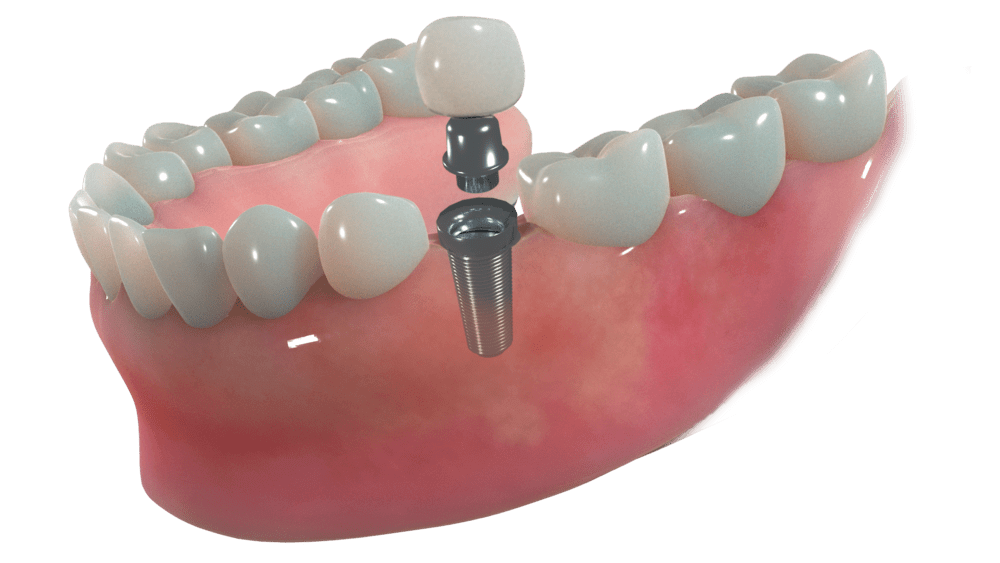A dental implant for the replacement of one missing tooth contains three important components.
– Implant body – The dental implant body replaces the root of the missing tooth by creating a solid connection with the surrounding jawbone. The implant body resides underneath the gums and is not visible to the naked eye.
– Abutment – The abutment attaches to the implant body and protrudes out of the gums. It serves as the core structure onto which your dentist builds the dental restoration.
– Implant crown – Just as a dental crown replaces and restores a damaged tooth, an implant crown replaces a missing tooth. It covers the abutment and reestablishes normal tooth shape, appearance, and function.
When it comes to replacing a missing tooth, a dental implant is as close as dentistry gets to a natural tooth. For that reason, the list of pros is much longer than the cons:
– Most natural appearance – Because dental implants create a restoration that emerges out of the gums in the same way that a natural tooth does, the result is the most esthetic, natural-looking tooth replacement when compared to other options.
– Best chewing function – A dental implant receives its strength from the jawbone, not relying on the support of other teeth as other tooth replacement options do.
– Preserves and protects surrounding teeth – Because an implant anchors within the bone, it does not require any preparation of or adjustment to adjacent teeth. In fact, the dental implant makes the neighboring teeth healthier because the implant puts no burden on them at all.
– Highest long-term success rate – A properly placed and maintained dental implant has a success rate higher than 95% at ten years. This is higher than any other tooth replacement option.
Preserves jawbone – The jawbone exists to hold teeth. When a tooth is missing, the jawbone slowly shrinks. By placing a dental implant, you prevent any shrinkage of jawbone and protect it for any future weight-bearing needs.
– Easiest to care for – As the dental implant leads to a tooth-like restoration, you can brush and floss it normally. There is no connection between the implant crown and the surrounding teeth. It is freestanding.

Because we respect each individual’s unique needs and desires, we take dental implants on a case-by-case basis. Some patients may undergo implant placement surgery in our office, and we refer others with complex medical needs or a desire for sedation to an oral surgeon. The recovery from a dental implant is easier than from an extraction. You may experience mild pain in the surgical site for up to a week.
Once the bone heals around the implant, your dentist will perform the remainder of the implant process and restore this once missing tooth to full function! An implant crown is much simpler than a dental crown because there is no preparation necessary. Your doctor selects the appropriate size and shape abutment and communicates this to the dental lab. We take a digital scan or mold or your teeth, including the location of the implant below the gums, to send to the lab for them to make your final crown. The lab returns the abutment and crown for its delivery. Your dentist confirms the correct fit and function before permanently cementing it into place.
For more information on dental implants, read our blog on A Guide to Restorative Dentistry.

Our team has delivered outstanding dental care in Rockwall for over 15 years. We are committed to providing our community with safe, gentle, high-quality dental care.
Should you have any questions or concerns regarding your dental care, we are more than happy to discuss how you can achieve a beautiful and healthy smile.
As a top dentist in Rockwall, we have helped hundreds of families achieve their oral health goals and are eager to help you and your family do the same.
Mon: By Appointment Only
Tue: 8am – 5pm
Wed – Thu: 9am – 6pm
Fri: 8am – 3pm
Sat – Sun: CLOSED
Mon: By Appointment Only
Tue: 8am – 5pm
Wed – Thu: 9am – 6pm
Fri: 8am – 3pm
Sat – Sun: CLOSED
Rockwall Dental Associates © 2024 | All Rights Reserved